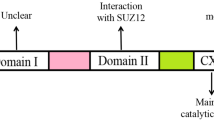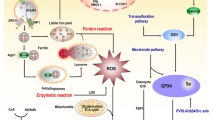Abstract
Four and a half of LIM-only protein 2 (FHL2) is an adaptor protein that can interact with many transcription factors and thus plays a variety of biological functions. Previous studies by our group have demonstrated that suppression of FHL2 was capable of inducing tumor cell differentiation, and inhibiting the growth of experimental gastric and colon cancers. Therefore, FHL2 appears to function as an oncogene. In order to further explore the mechanisms of how FHL2 is involved in tumorigenesis, we attempted to test whether FHL2 has any direct association with nuclear factor (NF-κB), the most important transcription factor involved in apoptosis, inflammation, and carcinogenesis. Using an Yeast Two Hybrid (Y2H) screening system, we have shown that FHL2 may have an interaction with NF-κBIα, the coding gene for IκBα which is the most potent endogenous inhibitor for NF-κB activation. However, subsequent studies using co-immunoprecipitation and co-localization failed to confirm the Y2H finding. Down-regulation of FHL2 by FHL2-siRNA down-regulated the expression of NF-κB p65. We therefore concluded that under the physiological condition, FHL2 may activate NF-κB pathway, even though such an activation may not be mediated by a direct binding of FHL2 to NF-κB inhibitor protein IκB.



Similar content being viewed by others
References
Chan KK, Tsui SK, Lee SM, Luk SC, Liew CC, Fung KP, Waye MM, Lee CY (1998) Molecular cloning and characterization of FHL2, a novel LIM domain protein preferentially expressed in human heart. Gene 210:345–350
Genini M, Schwalbe P, Scholl FA, Remppis A, Mattei MG, Schafer BW (1997) Subtractive cloning and characterization of DRAL, a novel LIM-domain protein down-regulated in rhabdomyosarcoma. DNA Cell Biol 16:433–442
Scholl FA, McLoughlin P, Ehler E, de Giovanni C, Schafer BW (2000) DRAL is a p53-responsive gene whose four and a half LIM domain protein product induces apoptosis. J Cell Biol 151:495–506
Kinoshita M, Nakagawa T, Shimizu A, Katsuoka Y (2005) Differently regulated androgen receptor transcriptional complex in prostate cancer compared with normal prostate. Int J Urol 12:390–397
Gabriel B, Mildenberger S, Weisser CW, Metzger E, Gitsch G, Schule R, Muller JM (2004) Focal adhesion kinase interacts with the transcriptional coactivator FHL2 and both are overexpressed in epithelial ovarian cancer. Anticancer Res 24:921–927
Wang J, Yang Y, Xia HH, Gu Q, Lin MC, Jiang B, Peng Y, Li G, An X, Zhang Y, Zhuang Z, Zhang Z, Kung HF, Wong BC (2007) Suppression of FHL2 expression induces cell differentiation and inhibits gastric and colon carcinogenesis. Gastroenterology 132:1066–1076
Wei Y, Renard CA, Labalette C, Wu Y, Levy L, Neuveut C, Prieur X, Flajolet M, Prigent S, Buendia MA (2003) Identification of the LIM protein FHL2 as a coactivator of b-catenin. J Biol Chem 278:5188–5194
Yan J, Zhu J, Zhong H, Lu Q, Huang C, Ye Q (2003) BRCA1 interacts with FHL2 and enhances FHL2 transactivation function. FEBS Lett 553:183–189
Martin BT, Kleiber K, Wixler V, Raab M, Zimmer B, Kaufmann M, Strebhardt K (2007) FHL2 regulates cell cycle-dependent and doxorubicin-induced p21Cip1/Waf1 expression in breast cancer cells. Cell Cycle 6:1779–1788
Muller JM, Isele U, Metzger E, Rempel A, Moser M, Pscherer A, Breyer T, Holubarsch C, Buettner R, Schule R (2000) FHL2, a novel tissue-specific coactivator of the androgen receptor. EMBO J 19:359–369
Fimia GM, De Cesare D, Sassone-Corsi P (2000) A family of LIM-only transcriptional coactivators: tissue-specific expression and selective activation of CREB and CREM. Mol Cell Biol 20:8613–8622
Samson T, Smyth N, Janetzky S, Wendler O, Muller JM, Schule R, von der Mark H, von der Mark K, Wixler V (2004) The LIM-only proteins FHL2 and FHL3 interact with a- and b-subunits of the muscle a7b1 integrin receptor. J Biol Chem 279:28641–28652
Tanahashi H, Tabira T (2000) Alzheimer’s disease-associated presenilin 2 interacts with DRAL, an LIM-domain protein. Hum Mol Genet 9:2281–2289
Purcell NH, Darwis D, Bueno OF, Muller JM, Schule R, Molkentin JD (2004) Extracellular signal-regulated kinase 2 interacts with and is negatively regulated by the LIM-only protein FHL2 in cardiomyocytes. Mol Cell Biol 24:1081–1095
Morlon A, Sassone-Corsi P (2003) The LIM-only protein FHL2 is a serum-inducible transcriptional coactivator of AP-1. Proc Natl Acad Sci USA 100:3977–3982
Chen D, Xu W, Bales E, Colmenares C, Conacci-Sorrell M, Ishii S, Stavnezer E, Campisi J, Fisher DE, Ben-Ze’ev A, Medrano EE (2003) SKI activates Wnt/b-catenin signaling in human melanoma. Cancer Res 63:6626–6634
Labalette C, Renard CA, Neuveut C, Buendia MA, Wei Y (2004) Interaction and functional cooperation between the LIM protein FHL2, CBP/p300, and b-catenin. Mol Cell Biol 24:10689–10702
Yang Y, Hou H, Haller EM, Nicosia SV, Bai W (2005) Suppression of FOXO1 activity by FHL2 through SIRT1-mediated deacetylation. EMBO J 24:1021–1032
Nair SS, Guo Z, Mueller JM, Koochekpour S, Qiu Y, Tekmal RR, Schüle R, Kung HJ, Kumar R, Vadlamudi RK (2007) Proline-, glutamic acid-, and leucine-rich protein-1/modulator of nongenomic activity of estrogen receptor enhances androgen receptor functions through LIM-only coactivator, four-and-a-half LIM-only protein 2. Mol Endocrinol 21:613–624
Stilo R, Leonardi A, Formisano L, Di Jeso B, Vito P, Liguoro D (2002) TUCAN/CARDINAL and DRAL participate in a common pathway for modulation of NF-kB activation. FEBS Lett 521:165–169
Kleiber K, Strebhardt K, Martin BT (2007) The biological relevance of FHL2 in tumour cells and its role as a putative cancer target. Anticancer Res 27:55–61
Bai S, Kitaura H, Zhao H, Chen J, Müller JM, Schüle R (2005) FHL2 inhibits the activated osteoclast in a TRAF6-dependent manner. J Clin Invest 115:2742–2751
James P, Halladay J, Craig EA (1996) Genomic libraries and a host strain designed for highly efficient two-hybrid selection in yeast. Genetics 144:1425–1436
Ding GR, Honda N, Nakahara T, Tian F, Yoshida M, Hirose H, Miyakoshi J (2003) Radiosensitization by inhibition of IkB-a phosphorylation in human glioma cells. Radiat Res 160:232–237
Lightcap ES, McCormack TA, Pien CS, Chau V, Adams J, Elliott PJ (2000) Proteasome inhibition measurements: clinical application. Clin Chem 46:673–683
Gao J, Pfeifer D, He LJ, Qiao F, Zhang Z, Arbman G, Wang ZL, Jia CR, Carstensen J, Sun XF (2007) Association of NFKBIA polymorphism with colorectal cancer risk and prognosis in Swedish and Chinese populations. Scand J Gastroenterol 42:345–350
Author information
Authors and Affiliations
Corresponding author
Rights and permissions
About this article
Cite this article
Qiao, L., Wang, Y., Pang, R. et al. Oncogene Functions of FHL2 Are Independent from NF-κBIα in Gastrointestinal Cancer. Pathol. Oncol. Res. 15, 31–36 (2009). https://doi.org/10.1007/s12253-008-9085-1
Received:
Accepted:
Published:
Issue Date:
DOI: https://doi.org/10.1007/s12253-008-9085-1




